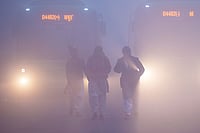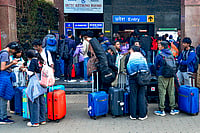How bad is the current state of the Indian economy? From all indications, thingsare pretty lousy. The half-hearted attempts made by the government to paint abrighter-than-actual picture of the economic situation seem to have miserablyflopped.
If anything, moves to project an optimistic future of the economy arebackfiring on the country's financial authorities: negative sentiments seem tobe feeding on one another to create a downward spiral of pessimisticexpectations.
It has been said that there are three kinds of lies: lies, damn lies andstatistics. The discipline of crunching numbers is often maligned. In alight-hearted tone, statistics is sometimes compared to a woman in a bikini:what is revealed, it is said, is suggestive; what is concealed, vital. Still,one can hardly talk about the economy without mentioning numbers.
Take the case of the latest figures released by the Central StatisticalOrganisation on Friday June 29. The data compiled by the CSO indicates thatIndia's gross domestic product (GDP) grew by 5.2 per cent in the financial yearthat ended on March 31, 2001. The GDP growth rate during the previous year washigher to the extent of 1.2 per cent, or 6.4 per cent.
It was only four months earlier, on February 28, that Finance MinisterYashwant Sinha had presented his Union Budget for 2001-02. During his speech inParliament on that occasion, he had made the following claim: "Overalleconomic growth this year is expected to be about six per cent despite a seriesof unexpected setbacks."
Within days of its presentation, Sinha's "dream" budget turned out tobe a nightmare, at least for the country's stockmarkets that collapsed like apack of cards in the midst of a major financial scandal reminiscent of a similarscam that had broken out nine years earlier. It now turns out that the FinanceMinister had painted an unrealistically rosy picture of the economy.
How does the CSO get its figures so wrong? After all, a difference of 0.8 percent of the GDP of a large country like India is not exactly small change. Ifone assumes the national income to be in the region of Rs 2,000,000 crore (orthe figure two followed by thirteen zeros), one per cent of GDP works out to Rs20,000 crore. In other words, how did the CSO get its figures wrong by as muchas Rs 16,000 crore?
Sinha was asked this question after he had inaugurated an insurance schemefor landless workers a day after the CSO figures were released. The FinanceMinister said he was disappointed with what had transpired. "My ownestimation was that because of a sharp reduction in agricultural production, thegrowth rate could go below six per cent. However, I had not anticipated thegrowth rate to be as low as 5.2 per cent," he was quoted as saying.
Sinha added that though he was not casting any aspersions on the CSO, duringthe last five years, the apex statistical organisation in the country hadrevised its GDP growth estimates upwards in all but one year, that is, 1997-98.That year, the CSO's "quick" estimates had suggested a growth rate of5 per cent against an actual growth rate of 4.8 per cent. In all the other fouryears, the CSO had scaled up its "quick" estimates.
The Finance Minister needs to go into this discrepancy a little more deeply.On what basis does the CSO releases its "quick" estimates? After whatkind of a time lag does it revise these figures to first become"advance" estimates and then "provisional" estimates? Andwhy does it often take the CSO as long as a year or so to finally "finalise"its figures?
A large number of detailed studies have been conducted by erudite scholars --statisticians and economists -- on why the government is unable to collectaccurate and reliable statistics and why it is unable to publish these on time.Nevertheless, a feeling persists that much remains to be done to streamline theCSO's operations.
Moving away from the issue of the authenticity of the CSO's estimates, thefact of the matter is that the bigger picture on the economic front is prettygloomy. When independent think tanks like the Mumbai-based Centre for MonitoringIndian Economy headed by Mahesh Vyas had questioned the government's GDPestimates, they had been chided for acting like prophets of doom. Yet, few careto recall such views when the government itself authenticates what had beenpredicted a few months earlier.
Sinha remarked that he was not commenting either way whether or not the CSOwould further change its figures when these are finalised. At the same time, theFinance Minister stated: ".but the fact that the Indian economy had sloweddown was known. It is not a revelation of the truth."
This is neither here nor there. Government spokespersons, including Sinha,are paid to be optimistic. But their optimism needs to be tempered by a certaindegree of realism. What has become amply evident now is that the slowdown in theeconomy had started some time ago and became obvious from around the beginningof this calendar year (at a time when the government was denying that anythingof the sort was taking place).
According to the CSO, whereas the country's GDP grew by six per cent on anaverage between April and October last year, during the last quarter of 2000,the growth rate fell to five per cent. The growth rate slumped further to 3.8per cent in the first three months of the current calendar year.
One significant aspect of the figures is that these depict a slowdown in eachand every sector of the economy. The primary sector, "agriculture, forestryand fishing" grew by a negligible 0.2 per cent in 2000-01 against 0.7 percent in 1999-2000. The manufacturing sector grew by 5.6 per cent against 6.8 percent in the previous year.
The story is repeated in other sectors of the economy. The "trade,hotels, transport and communications" sector expanded by 6.9 per cent lastfiscal year against 8 per cent in 1999-2000. The fall in the growth rate of theconstruction sector was sharper: from 8.1 per cent to 5.5 per cent. Even moresteep was the decline in the growth rate of "community, social and personalservices": from 11.8 per cent to 7.8 per cent, or a fall of four per cent.
As far the infrastructure is concerned, the "electricity, gas and watersupply" sector grew by 4.7 per cent during 2000-01 compared to 5.2 per centin the year before. The growth rate of the "financing, insurance, realestate and business services" segment of the economy too shrunk by one percent, from 10.1 per cent to 9.1 per cent.
What does all this mean for the growth rate of each Indian's income? Despitethe fact that these figures conceal the manner in which income has beendistributed among different sections of the population, the rate of growth ofper capita income (at constant 1993-94 prices) fell from 4.8 per cent to 3.5 percent. In absolute terms, per capita income in 2000-01 stood at Rs 10,561 againstthe "quick" estimate of Rs 10,204 in the previous year.
The jumble of statistics cited may appear confusing to some. But to placethese statistics in some kind of a historical perspective, one has to comparethem with figures indicating what had taken place in the economy during the twodecades before and after the process of economic liberalisation began. Thecontroversy relatesto whether the year 1991-92 should be placed in the pre-liberalisationera or the post-liberalisation phase because the economy had contracted duringthat particular year.
To be charitable to the government, let us compare the macro-economicstatistics of the eleven years between 1980-81 and 1990-91 with the eight-yearperiod between 1992-93 and 2000-01 (before the CSO revised its figures). Even ifsuch a comparison is made -- which is very favourable to the government - thepicture is not at all bright.
The average annual rate of growth of GDP had gone up from 5.4 per cent duringthe first period to 6.4 per cent in the next period. The agriculture sector'sgrowth rate slowed down from 3.9 per cent to 3.3 per cent. The growth rate ofindustry rose only marginally from 6.3 per cent to 6.5 per cent, while therelevant figures for the services sector went up impressively from 6.4 per centto 8.2 per cent. (These figures are taken from the last official Economic Surveyfor 2000-01 put out by the Ministry of Finance just before the presentation ofthe Union Budget.)
So is there anything to crow about as far as the performance of the Indianeconomy is concerned? The short answer is as follows: the services sector hasexpanded rapidly (this sector currently accounts for nearly half the country'sGDP) but the growth rate of industrial production has been lacklustre while thefarm sector has done quite poorly.
What makes things worse is the bad news on the employment front. There is noindication that job opportunities are going to go up. On the contrary, thelatest estimate of the Ministry of Labour is that the total number of jobs inthe organised sector of industry actually shrunk by 0.15 per cent during 2000after having gone up by a niggardly 0.04 per cent during 1999. This isreportedly the first time in a decade that employment in organised industry hasfallen.
The latest CSO figures make an already-bad picture appear worse. For one, thefiscal deficit as a percentage of GDP is up from 5.2 per cent assumed fourmonths ago to almost 5.8 per cent, the highest level in the last seven years.This makes the government's avowed intention of bringing down the fiscal deficitto around three or four per cent of GDP over the next five years appear analmost impossible goal.
Finance Minister Sinha has claimed the government would be stepping up publicspending to revive the economy. Among the plans on the anvil is to increaseexpenditure on Prime Minister Atal Behari Vajpayee's favourite highways buildingscheme. He said he would be meeting his ministerial colleagues, captains ofindustry as well as heads of banks and financial institutions in the comingweeks "to discuss measures to increase public expenditure".
One important factor that is working in favour of the government is thatrates of inflation are still low, below 5.5 per cent per year as measured by thewholesale price index. This is a major plus point. If, however, the governmentattempts adopting Keynesian techniques to pump up the economy by borrowingheavily to finance public expenditure programmes, such a strategy could stokethe fires of inflation. This, in turn, would be bad news for the NationalDemocratic Alliance government at a time when the country's most populous state,Uttar Pradesh, prepares for elections.
Sinha says "it is ultimately a question of generating demand in theeconomy". He is hopeful that the reduction in interest rates on contractualsavings schemes would "act as an incentive for growth". The FinanceMinister has no choice but to put up a brave front. It is to be hoped that he isnot being unrealistic. One wishes him lots of good luck. He certainly needs it.
(The author is Director, School of Convergence @ International ManagementInstitute and anchor of the "India Talks" programme broadcast on theCNBC India television channel.)
























